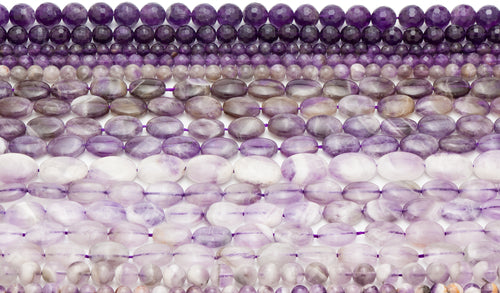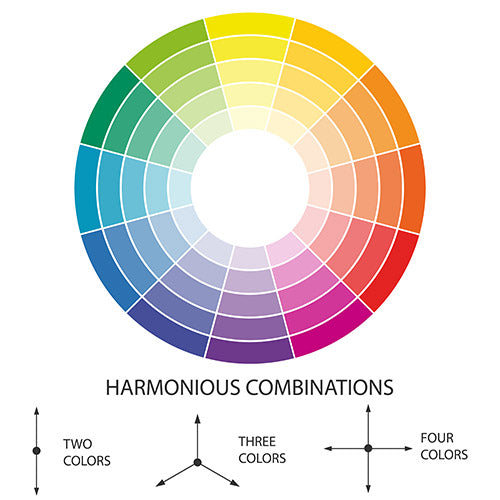6 Types of Amethyst Beads
Amethyst, with its easily recognizable rich purple tones, is at once both striking and calming, mesmerizing and exciting. A prized gemstone for centuries, amethyst can be found worldwide and is said to hold various healing and metaphysical properties.
Between its dazzling and unique color, rich history and the variety of shapes and shades of amethyst beads available to modern jewelry makers, it may just be the perfect addition to your jewelry collection.
What Is Amethyst?
Amethyst is a variety of quartz that appears in various shades of purple and violet. This unique hue is caused by the interaction of iron contained in each crystal and the gamma rays that pass through them.
It is regarded as one of the most popular and valuable quartz gemstones for a variety of reasons, not the least of which are its unique color in the gem world and easy moldability. In fact, the striking yet affordable material is often featured in a variety of jewelry and other decorative pieces, ranging from massive, raw geodes to eye-catching statement beads.
Amethyst in Culture
The name amethyst stems from the Greek word for sober, amethystos. In Greek mythology, it is said that Dionysus, the Greek god of wine, gave the stone powers to protect the wearer from drunkenness. For this reason, many individuals who are fighting problems with alcohol addiction wear amethyst as a talisman of mental clarity and support.
The ancient Egyptians, on the other hand, believed that amethyst gifted courage and protection to the wearer and the Egyptian princess Cleopatra was said to have worn an amethyst ring.
Today, Amethyst is one of the more well-known gems because of its use as the February birthstone. For spiritual individuals, amethyst also represents the spiritual center of the body as the crown chakra, and many cardinal rings and rosaries also feature the purple gem prominently.
Origins
Before the 19th century, amethyst was extremely expensive and only available to the wealthy due to its relative rareness. However, since then, large deposits have been found around the world, and it is now widely available and affordable.
Some of the largest producers of natural amethyst can be found in Bolivia, Brazil, Tanzania, Uruguay and Zambia, though it is also found in Arizona.

Six Types of Amethyst Beads
Amethyst beads appear in many shapes as well as various shades of purple. Amethyst colors range from light purple tints to nearly black gems.
Purple, ametrine, pink, mossy, cape and prasiolite are six of the most well-known types of amethyst.
Unlike other stones, amethyst’s value is based on its color rather than a carat weight, and the most valuable amethyst beads are those that are dark purple with reddish tints.
Some beads, like ametrine, are still considered part of the amethyst category, even though they are entirely different gems.
Pink amethyst beads, though still beautiful, are considered the least valuable, as they feature only a very light and indistinct lavender or lilac hue. Mossy amethyst beads can appear in both dark and light hues and have small veins that are visible throughout the bead.
Cape amethyst stones feature traces of milky white quartz throughout while ametrine, one of the rarest gemstones, contains a mixture of citrine (yellow) and amethyst (purple) in one single crystal. This rarely occurs in nature. However, the same effect can be produced using heat.
Prasiolite is quartz that features a yellow-green appearance with slight hints of purple throughout.
Pairing Amethyst with Other Gemstones and Metals

The purple tones of amethyst beads are relatively easy to pair with other colors and metals, and the standard color wheel can help you find colors that harmonize well with your purple amethyst.
For example, the colors that are found directly next to purple, such as other purple hues, pinks, blues and reds, represent a perfect harmonious color combination, meaning that rose quartz, lapis lazuli or even garnet beads can complement amethyst stones.
Contrasting colors, or those that appear directly opposite of each other on the color wheel, can make for a slightly different and more unusual jewelry combination. Purple gems contrast well with yellow crystals, like citrine beads, and amethyst with emerald beads is another stunning combination.
However, if you want the purple in your amethyst to really pop and remain the focal point of a piece, stick to gems like calcite, morganite or another toned down neutral.
When it comes to pairing amethyst with metals, the options are endless. White gold naturally enhances amethyst’s brilliance while a yellow gold pairing makes for a statement combination. In addition, brass and copper metals are excellent options for an amethyst jewelry piece.
Final Thoughts
Amethyst, with its range of distinct shades, is an excellent addition that rounds out any jewelry collection. The deep purple stones are the quintessential statement gem, while the more muted pastels are perfect for casual daily wear.
Whichever hue you choose, you are sure to love the variety and seemingly effortless glamour amethyst stones lend to your jewelry-making kit.
FAQ’s:
How much is a natural amethyst worth?
Amethyst is one of the most affordable gems. The average price may range between 20 and 30 dollars per carat. Even the particularly pure pieces of the gemstone can be bought at 40 or 50 dollars per carat. However, the price of the amethyst may vary as the value of this gemstone is based more on its color rather than a carat. The darker amethysts are the more valuable ones.
What are the different types of amethyst?
Amethyst beads are found in different shapes and various shades of purple. These are divided into different categories based on the color itself. The six popular varieties of amethyst are –
- Purple
- Ametrine
- Pink
- Mossy
- Cape
- Parasiolite
What does amethyst represent?
Amethyst, often described as a stone of peace, is one of the important stones in gemology. They are believed to be the carrier of soothing dreams where they bring the dreamer in tune with the divine. They provide clarity of thought and peacefulness to the mind. Experts believe that amethyst helps the mind flow freely in a mental as well as the metaphysical state.
How to tell if amethyst is genuine?
The color of an amethyst stone is the greatest indicator of its value as well as realness and fakeness. If you find a solid color amethyst, it is fake in all likelihood. Real amethyst gemstones have color zoning that includes shades of white and blue along with purple. You might find threads and impurities beneath the stone but real amethyst does not have bubbles.
What does amethyst represent?
Amethyst represents purity and the connection to divinity



